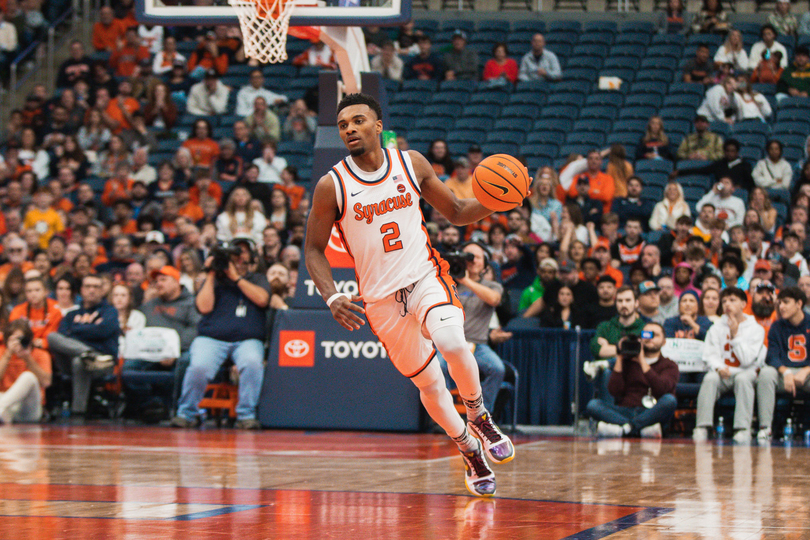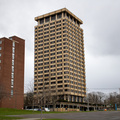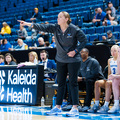Adrian Autry wants Syracuse to play fast. What does that mean?

After one of its worst seasons in program history last year, Syracuse men's basketball will look to up its tempo to improve this campaign. Leonardo Eriman | Photo Editor
Get the latest Syracuse news delivered right to your inbox. Subscribe to our sports newsletter here.
Adrian Autry tipped his hand about how he wanted Syracuse to play last November. The Orange narrowly escaped Colgate’s upset bid, and the head coach took the podium to speak with the media.
Within the first 30 seconds of his opening statement, Autry — who is typically soft spoken — passionately lauded how SU was playing at a higher pace than it had in a long time.
“Just stop talking about all this other stuff when you’ve got to talk about the style of play, what we’re doing and what things have changed,” Autry later said, gripping the podium with both hands. “Twenty to 25 more possessions. That’s what we’re doing.”
Despite Autry’s outlook after Syracuse’s second game of the year, the Orange didn’t play historically fast throughout the season. Instead, SU’s 68.4 KenPom Adjusted Tempo (AdjT) was the 124th-fastest in the country, slightly better than the final three years of Jim Boeheim’s 47-year head-coaching tenure — when it mostly leaned on a 2-3 defensive zone and played slow offensively.
Nonetheless, Autry prefers playing with pace. And as Syracuse tries to snap its four-year March Madness drought, it’s how Autry wants his team to play.
But why does this matter, and how does it work?
AdjT is an estimate of possessions per 40 minutes a team would have against a team that plays at an average Division I tempo. Last season, the highest AdjT was 75.3, the median was 67.5 and the lowest was 59.4.
Playing faster gives a team more possessions per game, which typically leads to more shot attempts and scoring opportunities. If a team can create a possession advantage over its opponent, the larger that discrepancy becomes, the more likely it is that the team will win.
“Basketball is a timed sport, so if your average possession length is 15 seconds, you’re going to have a lot more possessions over the course of a game than if your average possession is 27, 28, 29 seconds,” Jason Rohner, a bracketologist who runs @JBRBracketology on X, said.
While teams can control how early in the shot clock they get off a shot, arguably the most important aspect of playing fast stems from defense. Rafael Pinzon, who led Bryant in scoring last year when it made March Madness and had the sixth-highest AdjT in the country, noted that racking up turnovers and getting out in transition is the easiest way to score.
“Most of our transition and best fast breaks were after stops,” Pinzon said. “Because once (other teams) score, it’s a little harder to get in that mode of let’s run. That was the main thing, getting stops.”

Zoey Grimes | Design Editor
When SU won 20 games in Autry’s first season as head coach, it fit the bill of playing faster than its historical norm. The Orange’s 70.8 AdjT ranked 39th nationally, their best mark since placing 29th in the country during the 2008-09 season.
“It’s just the way I like to play,” Autry said of playing with pace after the Colgate game. “I think it’s exciting, you get a chance to play more guys. I think the really good teams, when you look at it, they play eight, nine guys.
“Certain games, it may be seven, but they can go nine, 10 deep sometimes. And I think as we continue to get better, we will be able to do that.”
While the Orange’s rotation fluctuated between eight and 10 players last season, they struggled to improve. Their 14-19 record was the program’s worst since the 1968-69 campaign.
But with an overhauled roster, featuring only J.J. Starling and Donnie Freeman returning alongside six transfers and five freshmen, Syracuse will try to play closer to its 2023-24 pace.
In Pinzon’s experience, playing with tempo needs to be practiced for several months so that a team is comfortable when the season starts. By around September and October, Pinzon felt Bryant fully knew how to operate.
To get there, Pinzon explained that the Bulldogs’ coaching staff constantly had them running and doing conditioning drills while also honing their individual skills.
On the court, Pinzon felt the freedom that the coaching staff gave the players was the most influential part of their success in playing a high-paced offense. He added that while playing fast may cause more turnovers, the coaching staff never benched him after a mistake.
Meanwhile, Pinzon added that the coaches always allowed him to take an open shot whenever he had a good look or dish to one of his teammates if he saw something.
“I think (playing fast) works because when you have five players playing free and making reads, it’s hard for teams to scout because you never know what’s going to happen,” Pinzon said.
On paper, the Orange’s 2025 roster is far more equipped to play with pace than last year’s squad. They replaced starting center Eddie Lampkin Jr. — who had limited mobility — with a tandem of slightly undersized, yet athletic centers in William Kyle III and Ibrahim Souare.
Georgia Tech transfer Naithan George should also run SU’s offense far better than Jaquan Carlos did last year. George’s 6.5 assists per game led the Atlantic Coast Conference last season, and he played like one of the best guards in the conference down the stretch. Carlos, meanwhile, wasn’t much of a threat with the ball.
With athletic, versatile forwards in Freeman, Sadiq White Jr. and Tyler Betsey, and a skilled guard group led by Starling, Nate Kingz, Kiyan Anthony and Luke Fennell, Syracuse can not only play fast and efficiently.
“When we built this team, we wanted to get bigger, quicker and maintain our skills,” Autry said at ACC Tipoff on Tuesday. “Increase our athleticism. That was the main focus of putting together this roster.”
Besides a lack of talent and cohesion, last year’s SU squad didn’t have an identity. This campaign, Autry is hoping to mold Syracuse into a team where its pace and athleticism run opposing teams out of the gym.
If his vision becomes a reality, the Orange could see themselves back where the program belongs — March Madness.






